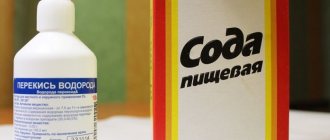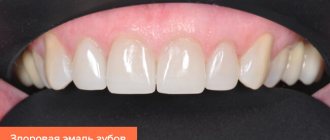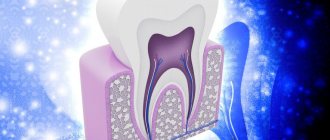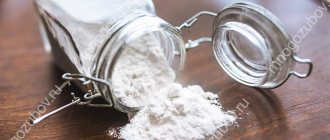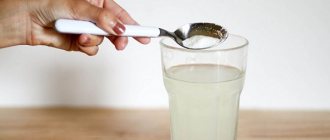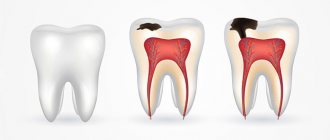On the Internet you can find many recipes and tips for home enamel whitening. One popular method is to use baking soda. Almost everyone has this product in their home, and it costs mere pennies. These factors are responsible for the popularity of soda for dental purposes. Indeed, in this way it is possible to lighten the teeth, but no more than 1-2 tones. In order not to spoil your teeth, harm your mouth or damage your enamel, we have prepared 5 main points that need to be observed.
Check out the list of restrictions
Since soda consists of abrasive particles, keep in mind that in addition to plaque, minor damage to the top layer of enamel occurs. For this reason, it is highly recommended not to use soda for people with hypersensitive enamel. It is also prohibited to perform this manipulation if the gums are sore or bleeding.
Also note that home teeth whitening will not work on teeth with tetracycline or dental fluorosis. In these situations, the only effective method is professional chemical whitening, which is performed only in dentistry.
Contraindication to bleaching with soda
Dentists advise that before starting the whitening procedure with soda, visit the dental office and check the health of your teeth.
Also, this method of whitening, like some other methods, is not recommended for those who:
- have periodontal disease;
- gums bleed;
- ulcers and stomatitis are observed in the oral cavity;
- teeth are overly sensitive;
- tooth enamel is very thin;
- superficial caries is observed or molars are affected;
- There are crowns in front, which will become even more noticeable after the whitening procedure.
Safe amount of soda
Home enamel lightening is a gradual process. Do not expect that you will achieve the desired result in one procedure. You need at least 3-4 manipulations to whiten your teeth by 2 shades. You can only use baking soda to brush your teeth once a week. We can conclude that the result will be noticeable only after a month.
You can leave the baking soda on your teeth only for 60 seconds, then you need to quickly wash the composition off the enamel. There is no point in holding it longer; it will not enhance the effect, but will significantly increase the risk of unpleasant consequences.
Why is home whitening worse?
Many people prefer homemade recipes to salon teeth whitening treatments. Indeed, why spend money and do whitening procedures with a soda machine in the dentist’s chair if you yourself know how to whiten teeth with soda. In fact, it turns out that no matter how effective home recipes are, professional cleaning is better and safer.
Baking soda contains larger particles and is therefore more abrasive. In combination with a hard brush, it can damage the enamel. During a similar procedure in the office, dentists do not always use baking soda. Calcium carbonate powder and glycine powder are used, each with a different abrasiveness and purpose.
During the procedure, dentists use a special hydraulic device, which reduces the abrasiveness of soda using a jet of water. Hydraulic cleaning helps to penetrate hard-to-reach areas and remove plaque even between teeth and under the gums.
After cleaning with a soda machine, the enamel surface must be polished. If this is not done, it will become porous and will collect plaque even faster.
Baking soda itself does not help whiten teeth; it only removes pigmented plaque from the surface of the enamel. With frequent and unprofessional use, soda can damage the enamel, but, unfortunately, it is not restored.
How to save the effect
After you have completed the course of four treatments, you most likely got what you wanted. To prevent your teeth from darkening again after the first use of coloring products, you must follow a number of rules:
- Follow the “white” diet for 7 days. This diet excludes coloring foods. It is based on fermented milk products, white meat, cereals, broths and chicken eggs.
- After eating, rinse your mouth. You can use professional products or plain water.
- Reduce your consumption of coffee, tea and cigarettes to a minimum. Otherwise, the result will only last for a few weeks.
It is highly not recommended to get carried away with soda bleaching. The home whitening course can be repeated no more than twice a year. I would like to note that the greatest effect can be achieved with professional teeth cleaning using the Air Flow system. This is beneficial for the oral cavity, does not cause complications, removes pathogenic microorganisms, and, as a bonus, the enamel lightens by 1-2 tones.
Teeth whitening at home with soda: methods of application
Dentists do not recommend using pure soda for teeth whitening, which can have a negative effect on the enamel. Therefore, if you decide to use soda to make your teeth white, supplement it with various substances.
- Baking soda and hydrogen peroxide. Prepare a solution of three percent hydrogen peroxide and soda (mix until smooth) and brush your teeth (brush for no longer than 3-4 minutes). Then rinse your mouth and brush your teeth with fluoride paste.
- Soda with lemon juice. Sprinkle a little baking soda on a damp toothbrush (you can use a cotton pad) and add a couple drops of lemon juice. Wipe or brush your teeth with the resulting product, then rinse with water.
- Soda and strawberries. Mash a couple of ripe strawberries and add a pinch of soda to the pulp. Apply the resulting substance to the entire dentition using a soft brush, leave for five to eight minutes and rinse. Rinse your mouth with filtered water (you can use boiled water) and clean your mouth with fluoride paste.
- Soda and iodine. This remedy has proven its effectiveness not only in the fight against plaque, but also against tartar and bacterial diseases of the oral cavity. To prepare a slurry of optimal consistency, you need to take a teaspoon of soda, add a couple of drops of iodine to it and mix with a toothpick or match. For best effect, you can hold the product on your teeth for a couple of minutes. Then rinse and rinse thoroughly, brush your teeth with regular or fluoride-containing toothpaste. Attention: this remedy is not suitable for allergy sufferers or those with endocrine diseases.
- Soda and vinegar. Mix these two substances until a homogeneous paste is obtained. Apply it to your teeth using a cotton pad, brush or fingers, and massage gently for several minutes. Rinse and rinse mouth thoroughly.
- Soda with peroxide and lemon. Take half a teaspoon each of lemon juice and soda, add five drops of peroxide (three percent). Using your finger, apply the product to your teeth and distribute evenly. Try not to get it on your gums. Wait a couple of minutes and rinse off using warm water. Brush your teeth and rinse your mouth well.
- Soda and toothpaste. Add soda to regular toothpaste, mix and brush your teeth as usual.
- Soda and activated carbon. Grind activated carbon, mix with soda (in equal proportions), add two drops of hydrogen peroxide and lemon. Brush your teeth with the resulting mixture, then rinse with warm water several times.
Regardless of the whitening method you choose, remember that using soda frequently is unacceptable. After the procedure, it is not advisable to drink hot and cold drinks (at least for an hour), and give up strong tea, coffee, wine and cigarettes for at least a day in order to maintain the whitening effect.
If these methods seem ineffective to you, try ASEPTA PLUS Gentle Whitening toothpaste. The enzyme papain included in its composition effectively breaks down plaque, and pyrophosphates dissolve the mineral component of deposits on the teeth. Your smile will become snow-white!
What are the benefits of toothpaste for facial skin?
The product has a gentle effect on the oral mucosa, so it is absolutely harmless to the face.
To achieve maximum effect, the following toothpaste is suitable:
- absolutely white without dyes;
- without abrasive components;
- no flavorings.
You can use tooth powder, which is diluted with warm water until creamy. Using the product helps achieve the following results:
- removing impurities and sebum from pores;
- relieving inflammation;
- whitening acne spots;
- toning the skin.
Toothpaste has antibacterial and antiseptic effects. It can deeply cleanse and gently dry the skin.
Advantages and disadvantages of the procedure
Positive sides:
- Quick results. In a single visit, you can noticeably lighten the enamel by several tones, the effect depends on its condition.
- No medical indications. The client of the dental clinic decides for himself whether he needs to whiten his teeth.
- Many methods with different effects and prices.
- No pain or other discomfort.
- Almost all methods are universal, which means they can be used for patients of different ages.
- There is no need to go through a recovery period.
- Getting rid of complexes and awkwardness when communicating with others.
The technique also has negative aspects:
- The most effective methods have a high cost.
- The effect does not last long. The smile will remain snow-white for 5-7 years, but no more.
- Increased sensitivity of enamel, its thinning. Pain may occur while eating if the food or water is too cold or too hot.
- Inability to change the color of filling material, implants, artificial crowns.
- The risk of losing the natural shade of teeth and excessive whiteness increases.
- The need to adhere to dietary nutrition to maintain results. It is not recommended to drink coffee, strong black tea, or eat foods with a high concentration of bright natural pigment.
Photos before and after
According to the principle of action, cleansing with soda looks like this: solid elements of the substance that have abrasive properties, during the process of application and distribution, remove dirt from the teeth, as well as a thin layer of enamel. As a result of this effect, the teeth return to their original color and become whiter. In most cases, the whitening effect becomes visible after 2-3 procedures.
Cause of blackheads
The main cause of blackheads is increased sebum production. The following factors can cause this process:
- poor skin care;
- disruptions in the endocrine system;
- use of low-quality cosmetics;
- long-term use of medications;
- poor nutrition;
- gastrointestinal disease;
- genetic predisposition;
- bad habits;
- individual characteristics;
- regular stress;
- hormonal disbalance.
Blackheads have a negative impact on your appearance. It is not recommended to ignore their presence, especially since there are many home recipes for eliminating skin imperfections.
Preparation
To reduce the harmful effects on the enamel, the procedure can be carried out only after certain preparation. So, it is recommended to strengthen the enamel with fluoride . Vitamin-mineral complexes and special toothpastes will help with this. They need to be used twice a day for two weeks.
It would be a good idea to add foods rich in calcium and fluoride to your diet. These include:
- greenery;
- cottage cheese;
- green tea;
- fermented milk;
- grapefruit;
- apples;
- potato;
- seafood;
- oatmeal;
- buckwheat grain.
Gums also need strengthening: special mouth rinses will help. Preparation begins at least a month before the planned teeth whitening with soda at home.
Is it possible to brush your teeth with baking soda every day?
Dentists have a negative attitude towards any abrasive products, therefore, from a professional point of view, daily brushing of teeth with soda is prohibited. It was already mentioned above that daily use leads to destructive processes in tooth tissue, but people still strive to achieve positive dynamics and consolidate this result for a long time.
Carefully! It is impossible to achieve a lasting result with whitening soda. Excessive efforts will lead to other dental problems that cannot be treated at home.
The effect after brushing teeth with soda does not last long, which explains the desire of patients to use this method of hygiene more often. However, daily use thins the enamel more and more. Dentin, which is much darker, begins to appear through the thin enamel layer.
As a result, the teeth become even darker than they were before and it will no longer be possible to achieve lightening at home. In addition, thin enamel easily allows waste products of pathogenic microflora, which are the source of the development of most dental diseases, to pass through it.
Dentist on brushing teeth with soda:
Is it possible to brush your child's teeth with baking soda?
It is better not to brush teeth with a milk bite with soda. There are several reasons for this:
- The enamel is already white and does not need bleaching.
- The enamel is not fully formed and is very porous, which can contribute to its rapid destruction.
How to reduce harmful effects
A dazzling smile does not mean that your teeth are completely healthy. Behind the thin enamel is dentin. It is a structure with yellowish or grayish pigmentation. Whitening uses active chemical compounds that lead to thinning of the enamel layer or damage to its integrity. This also affects the condition of the oral cavity.
To minimize negative consequences, the dentist performs the following actions:
- Conducts a visual inspection and assessment of the condition of hard and soft tissues in the mouth.
- Identifies possible contraindications.
- Selects a safe and effective method of teeth whitening.
- Uses any available methods to diagnose and relieve pathological processes.
What could be the negative consequences?
Dentists do not recommend using baking soda to whiten tooth enamel. The fact is that such a procedure is completely unsafe and after it a variety of complications can arise.
Thus, when using sodium bicarbonate for teeth whitening, the following negative consequences can be regularly observed:
- The surface of the mucous membrane in the mouth will become irritated.
- Tooth enamel will gradually become thinner and thinner.
- There is a high risk of gum bleeding.
- An allergic reaction may develop. So, a rash may appear near the lips.
- Your teeth will become more sensitive. Moreover, if there is something cold, sour or hot, pain will be felt.
If the whitening procedure is carried out incorrectly or too often, this can lead to damage to tooth enamel. Also, after some time, blackening of the tooth enamel may occur.
Three main ways
There are 3 ways to use soda:
- Dry soda for whitening. Take a damp cotton pad and apply sodium bicarbonate to it. You can sprinkle the product onto your fingertips and brush your teeth.
- Water-based bleach. Mix sodium bicarbonate with water until completely dissolved (1:1). Apply the composition to a cotton pad and begin processing.
- Combined mixture. You can add various substances to soda - hydrogen peroxide, salt, citric acid, chopped bananas.
After each whitening procedure, you must brush your teeth in the standard way - with a brush and toothpaste.
Rules of application
To achieve white teeth without damaging the enamel layer of the tooth, you need to use sodium bicarbonate a maximum of once a month. In this case, you need to use it mixed with water, the consistency should be mushy. You can use any other solvent.
Attention! Do not use dry soda under any circumstances; it can leave scratches on the enamel layer.
This is what the paste should look like
In addition, dry soda powder feels like sand in the mouth, which causes discomfort. It is better to use the product in diluted form, mixing it with toothpaste or other substance.
There are several proven recipes for preparing homemade soda pastes and solutions, which will be discussed below.
The method of brushing your teeth can be standard, but it is better to use circular movements of the brush. This will not only clean the tooth surfaces, but also massage the gums, improving tissue trophism.
Whitening teeth under braces
Teeth with braces require special care. If the patient neglected the doctor’s recommendations, drank a lot of strong coffee or tea, then the teeth become unsightly and acquire a yellowish tint. It is better not to whiten your teeth before removing braces, because most of the tooth is under the structure. As a result, after removing braces, dark spots may form on the teeth, because... Lightening gels are not included in the design. In addition, wearing braces is stressful for tooth enamel, which endures a lot of stress. She becomes more sensitive and vulnerable. Therefore, those who wear braces have teeth that are more prone to decay. Dentists recommend postponing the whitening procedure until the system is removed.
The only sure thing for people wearing braces is to visit a dental hygienist regularly to have their teeth cleaned. This procedure will help get rid of yellow plaque.
Rules
It is important to remember that the interval between home whitening procedures should not be shorter than indicated in the prescription. Many people, inspired by the results of the first procedure, rush to repeat it again. The whiteness will become brighter, but the lifespan of the teeth is reduced so much that there is no talk of benefit. It is most rational to carry out bleaching rarely, but with a clear frequency, then the result will be noticeable and will not provoke disastrous consequences.
During whitening, you need to make sure that soda does not get on the gum tissue, as this causes irritation, burns and microtrauma. Sodium bicarbonate is too aggressive a substance for the delicate mucous membrane of the oral cavity.
How to do this without harm?
Using baking soda as a tooth powder has a lot of advantages:
- This remedy neutralizes pathogenic microflora of the oral cavity, resulting in the disappearance of bad breath.
- Sodium bicarbonate allows you to polish tooth enamel even in the most difficult to reach places.
- Baking soda relieves gum inflammation.
To care for your teeth, choose a brush of suitable hardness.
At the same time, sodium bicarbonate powder can cause harm if handled without taking precautions. It should be remembered that the drug is contraindicated in the following disorders:
- Bleeding gums.
- Inflammatory processes in the oral cavity.
- Sensitive tooth enamel.
The absence of contraindications does not mean that soda can be safely used as many times as desired. Healthy teeth can also be damaged if whitened without care. After all, sodium bicarbonate destroys not only harmful, but also beneficial microflora. In addition, soda is often mixed with other aggressive substances - hydrogen peroxide, citric acid, fruit juice, etc. Such combinations have an aggressive effect on tooth enamel, so they should be handled with extreme caution.
For whitening, it is recommended to use a brush with soft bristles that will gently massage the gums. A cotton or gauze swab is also suitable for this purpose.
Whatever tool you use for cleaning, it is important to do it carefully without touching your gums, because the mixture can be very irritating to them.
The site sympaty.net studied many different sources and collected the best recipes for brushing your teeth with soda to whiten them. They have different effectiveness, but they all have one thing in common: they cannot be used more than once a week. Some recipes can be used once every few months.
Remember that bleaching should not be done often!
Pros and cons of cleaning with soda
A procedure such as whitening tooth enamel with regular baking soda has several pros and cons.
Pros:
- baking soda is available in almost every home;
- if necessary, sodium bicarbonate can be purchased at any grocery store, while 1 pack costs only about 25–30 rubles;
- tooth enamel becomes whiter after just one procedure.
Minuses:
- Sodium bicarbonate acts on tooth enamel as an abrasive substance, that is, cleansing occurs due to the fact that plaque is removed mechanically. In this case, there is a strong impact on the enamel, as a result of which scratches appear on it, and it gradually begins to become thinner.
- The result achieved during whitening does not last long. So, just a few days after the procedure, darkening of the teeth occurs.
- If a whitening agent made with sodium bicarbonate gets on your gums, it can cause injury. Often there are such side effects from these procedures as: bleeding gums, irritation of the oral mucosa and allergic reactions.
- Over time, teeth become more and more sensitive. This is because their enamel is regularly damaged. If you do not whiten tooth enamel according to the rules, the consequences can be extremely serious and irreversible.
Useful properties of soda
To prepare the scrub, use regular baking soda. Carbon, sodium and oxygen with hydrogen included in its composition have the following positive effects:
- even out skin tone;
- destroy pathogenic microorganisms;
- stop inflammatory processes;
- remove keratinized particles;
- normalize the functioning of the sebaceous glands;
- stabilize the acid balance of the epidermis;
- improve the functioning of blood vessels.
Baking soda against blackheads is used quite often. It's like a sponge that pulls out all the dirt from the surface and gets rid of grease.
How to whiten tetracycline teeth?
Tooth enamel can change its color while taking tetracycline antibiotics. Teeth may become dirty yellow, brown, or dark gray. Children's teeth during the period of formation and taking antibiotics of this type are especially susceptible to color changes. It is quite difficult to whiten such teeth, since the coloring pigment is located quite deep. No home remedies or techniques will bring results. The only way out in this case is to go to the dentist and get professional whitening. In addition, there is a high probability that several procedures will be required.
Preparation of soda solutions for brushing teeth
To cleanse tooth enamel, you can prepare several different soda solutions:
- With water. If you dissolve sodium bicarbonate in water, it will not lose its cleansing properties, but the effect will be less noticeable. But this method is safer and more gentle than cleaning with dry soda.
- With peroxide. This solution has a fairly strong effect, but it must be used for its intended purpose very carefully.
- With peroxide and citrus. If you combine baking soda, peroxide and lemon juice, you get a super effective mixture for teeth with a whitening effect. However, it should be used with extreme caution and only if all teeth are absolutely healthy.
- With lemon. You can mix sodium bicarbonate with lemon. In this case, you will also get a fairly effective bleaching agent, but it can seriously damage the enamel.




